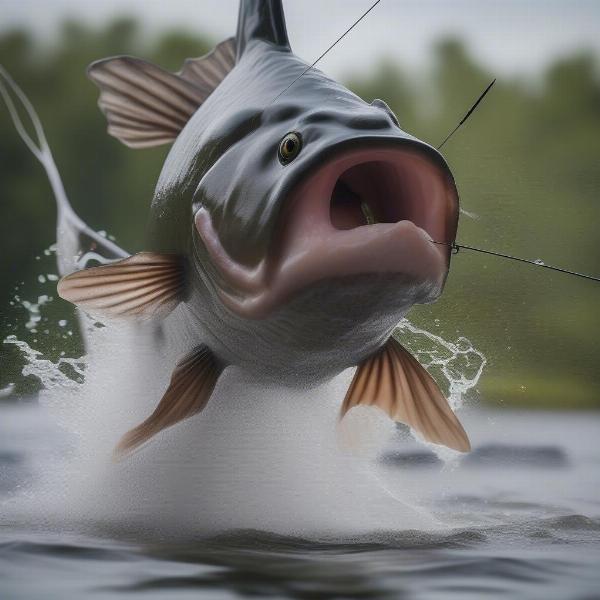Catfish are a popular target for anglers across the globe. But Is Catfish A Game Fish? The answer isn’t as simple as a yes or no. It depends on who you ask and where you’re fishing. This article dives deep into the world of catfish angling, exploring the characteristics that define a game fish and examining why catfish sometimes fit the bill and sometimes don’t.
Defining a Game Fish: What Makes a Fish a Worthy Opponent?
What exactly qualifies a fish as a “game fish”? Traditionally, game fish are prized for their sporting qualities – they offer a challenge to anglers due to their strength, fighting ability, and elusiveness. Think of species like marlin, tuna, or salmon leaping from the water, testing the angler’s skill and equipment. Game fish are also often sought after for their culinary appeal, adding another layer of desirability to the pursuit.
Other factors contributing to a fish’s “game” status include its rarity, the beauty of its appearance, and the specialized techniques required to catch it. The exclusivity associated with catching certain species elevates their perceived value among anglers.
Why the Debate? Is Catfish a Game Fish? The Arguments For and Against
The debate about whether catfish are game fish hinges on how well they fit these criteria. Some anglers argue vehemently that catfish deserve the title, citing their impressive size, powerful fights, and delicious taste. Larger catfish species, like the blue catfish, can grow to enormous proportions, providing a thrilling battle on the line. Their strength and tenacity can test even the most experienced angler.
However, others argue that catfish lack the acrobatic displays and refined feeding habits of classic game fish. They often point to the catfish’s bottom-feeding nature and tendency to scavenge, contrasting it with the predatory pursuits of species like bass or trout. This perception of catfish as less “sporting” contributes to the ongoing debate.
The Case for Catfish: Strength, Size, and Culinary Appeal
Let’s delve into the arguments supporting catfish as a game fish. The sheer size potential of some catfish species is undeniable. Blue catfish, flathead catfish, and channel catfish can all reach impressive weights, offering a formidable challenge to anglers. Landing a monster catfish requires heavy tackle, skillful technique, and a healthy dose of patience. The fight these fish put up is anything but boring. They utilize their powerful muscles and broad bodies to resist capture, making for an exciting angling experience.
Beyond the fight, catfish are renowned for their culinary versatility. From fried catfish fillets to blackened catfish tacos, the possibilities are endless. This culinary appeal adds another dimension to the pursuit of catfish, making them a desirable target for anglers who enjoy a tasty meal after a day on the water.
 Catfish Fighting on a Fishing Line
Catfish Fighting on a Fishing Line
The Case Against Catfish: Bottom-Feeding and Lack of “Flash”
The primary arguments against catfish as game fish often center on their bottom-feeding habits and perceived lack of sporting behavior. Unlike predatory fish that actively hunt their prey, catfish often scavenge along the bottom, feeding on dead or decaying matter. This scavenging behavior, while ecologically important, can be seen as less exciting than the predatory pursuits of other game fish.
Furthermore, catfish generally lack the acrobatic leaps and surface displays that characterize many popular game fish. While they certainly put up a strong fight, it’s often a brute-force struggle rather than a visually stunning aerial display. This difference in fighting style contributes to the perception of catfish as less “sporting.”
So, Is Catfish a Game Fish? It Depends on Your Perspective
Ultimately, whether or not you consider catfish a game fish depends on your personal definition. If you value a strong fight, a challenging catch, and a delicious meal, then catfish undoubtedly fit the bill. If you prioritize acrobatic displays and predatory behavior, you might lean towards other species. There’s no right or wrong answer, and the beauty of fishing lies in the diverse experiences it offers.
 Angler Holding a Large Catfish
Angler Holding a Large Catfish
Catfish Fishing Techniques: A Sport in Itself
Regardless of where you stand on the “game fish” debate, catfish fishing offers a unique and rewarding experience. From the anticipation of the bite to the thrill of the fight, catfish angling has its own dedicated following. Specialized techniques, like using stinkbait or trotlines, add another layer of complexity and challenge to the sport.
For many anglers, the appeal of catfish fishing lies in its accessibility. Catfish are widely distributed, and they can be caught from a variety of habitats, from rivers and lakes to ponds and reservoirs. This accessibility makes catfish fishing a popular pastime for anglers of all skill levels.
Why Do People Fish for Catfish? Beyond the Game
Even if some don’t consider it a game fish, millions of people around the world actively target catfish. So what’s the draw? Beyond the challenge and the tasty fillets, catfish fishing offers a connection to nature and a sense of accomplishment. It’s a chance to escape the hustle and bustle of everyday life and enjoy the tranquility of the outdoors. Whether you’re a seasoned angler or a beginner, catfish fishing provides a rewarding experience that can be enjoyed by all. Similar to the reasons why do people throw catfish at hockey games, the cultural significance of this fish is undeniable.
 Various Catfish Fishing Techniques
Various Catfish Fishing Techniques
Conclusion: Appreciating the Catfish for What It Is
Whether or not catfish are classified as “game fish,” their popularity as a target species is undeniable. Their strength, size, and culinary value offer a unique angling experience. So next time you’re on the water, consider targeting these fascinating fish. You might be surprised at the challenge and reward they offer. Is catfish a game fish? Maybe the better question is, are you ready for the fight?
FAQ
- What is the largest catfish ever caught? The current world record for a Mekong giant catfish is a staggering 646 pounds.
- What is the best bait for catfish? Catfish are opportunistic feeders, but popular baits include stinkbait, chicken liver, and nightcrawlers.
- Where can I find catfish? Catfish are widely distributed and can be found in rivers, lakes, ponds, and reservoirs throughout much of the world.
- What kind of tackle do I need for catfish fishing? The tackle you need depends on the size of catfish you’re targeting. For larger catfish, heavier rods, reels, and lines are necessary.
- Are catfish good to eat? Absolutely! Catfish are a popular food fish and can be prepared in a variety of ways.
- What is the difference between channel catfish and blue catfish? Channel catfish are generally smaller than blue catfish and have a forked tail. Blue catfish have a straight, squared-off tail.
- How do I clean a catfish? Cleaning a catfish involves removing the skin, head, and internal organs. Several online resources provide detailed instructions.

